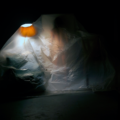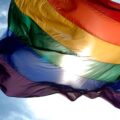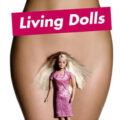Subject to Change: On Not Having, or Being, it All

The word queer has gone through many transformations since it emerged in the 16th century. Originally, it meant “strange,” or “peculiar”: associated meanings included a feeling of unwellness or something suspicious. By the time Sherlock Holmes published the story “The Adventure of the Second Stain” in 1904—in which Inspector Lestrade threatens that a misbehaving constable will “find [himself] in Queer Street,” a euphemism for losing his job—the term “queer” had become a derogatory term for men in same-sex relationships. By that time, the term “invert,” coined by English poet and author Radclyffe Hall, had replaced “queer,” and, later, “homophile.” By the end of the 1960s, “gay” had become the umbrella terms for those in same-sex partnerships. The term “queer” had begun to be reclaimed by the late 1980s from its pejorative use to a positive self-identifier by LGBT people.
Today, queer can be used as an adjective, a pejorative, a noun, an identity, a sexual orientation, and as a gender identity (as in genderqueer).
It can also be used as a verb.
To queer something, whether it’s a text, a story, or an identity, means examining its foundations and questioning them. To queer is to examine our assumptions and practice transcending the habit of settling for pre-defined categories. The work of queering subjectivity, or motherhood, or any other phenomenon or institution, will question authenticity and sincerity. These are questions that strike at the heart of what it means to produce meaning and what it means to think through the historical and cultural interpretations of a word.
The word etymology derives from etymos, an adjective meaning “real, true, actual,” and logos, the basic noun for “story, account, analysis.” Etymos in turn has an etymology: from einai, the verb “to be, to exist.” So an etymology can be thought to give the true meaning of a word because it has “is-ness” in it.
Even the most trenchant of anti-essentialist arguments cannot evade the Derridean “trace” of thing-hood or “is-ness” in a word as it was originally created and used. Queering, as an act of ongoing transformation—much like metaphoric thinking—is one way to discover new freedom and flexibility. Thinking of queer as a verb is liberating because it becomes something we can choose, in much the same way that bell hooks suggests making love an action and a choice, rather than only thinking of it as a noun.
Each time we discover a new word or identity or category, we can choose to queer it. And when we create new words or identities, we can queer them. It’s a practice, rather than a goal or finished product.
Theorist Eve Kosofksy Sedgwick wanted to make way for “queer” to hold all kinds of resistances and slippages that have little or nothing to do with sexual orientation. “Queer is a continuing moment, movement, motive—recurrent, eddying, troublant,” she writes. “Keenly, it is relational, and strange.” Sedgwick wanted the term to be a perpetual excitement, a kind of placeholder—a nominative, willing to designate molten or shifting parts, a means of asserting while also giving the slip. That is what reclaimed terms do—they retain, they insist on retaining, a sense of the fugitive.
I’m interested in the difference between the “choice” to bear a child versus the “inability” to conceive, asking the question: how does this rhetoric around “choice” and “ability” shift when we account for economic hardship and infertility? How can we become more sensitized not only to the racial, gender, and sexual politics that inflect the choice to bear a child, and in what familial context, but also the issue of class privilege and ableism, in assuming that otherwise healthy women of child-bearing age have both the financial means as well as the physical ability to have a child, single or with a partner, and raise that child or children?
Like confessional poetry, some sneeringly consider a memoir to be a “lesser art” than, say, academic prose or fiction. But the memoir, like motherhood, is deeply phenomenological and thus hard to pin down, as an experience or genre. And the contemporary “mom-oir,” as some call memoirs about motherhood, is a hybrid.
Discussing her book The Argonauts in an interview, Maggie Nelson describes it not as memoir but as “auto-theory.” The word memoir, she explains, “has connotations about ‘taking stock of a whole life via the act of memory’ that don’t appeal to me, and don’t seem germane to the different kinds of life-writing that I’ve set forward. So I prefer life-writing, or here, ‘auto-theory,’ which is cribbed from 70s feminists by way of Beatriz Preciado, as it points to the theoretical nature of the autobiographical ruminations at hand. And for all those who say, ‘I didn’t like all the theory, I just wish she’d told us more about her,’ I can at least say, you were warned!”
There is value in thinking about similar hybridities in other memoirs—books including Cherrie Moraga’s Waiting in the Wings (1997), Anne Lamott’s Operating Instructions (1993), Carole Maso’s The Room Lit by Roses (2000), A.K. Summers’ Pregnant Butch (2014), and Jennifer Finney Boylan’s Stuck in the Middle with You (2013), among others.
While vastly different in terms of approach and content, these texts have in common a shared context of family-building and mothering outside the confines of heterosexual partnerships. They share a certain self-reflexiveness and awareness of narrative construction that is often rendered invisible in other mother memoirs. All written prior to the 2015 Supreme Court ruling about same-sex marriage, these memoirs also have significant social and political implications, most notably the co-implicated attempts to address homophobia and “normalize” families headed by gay and lesbian parents.
Trafficking in high theory and pop culture, from Gilles Deleuze to the X-Men, The Argonauts raises vital questions about form and content. Trying to summarize it is nearly impossible. During the span of time The Argonauts covers—2007 through 2013—Nelson falls in love, marries, and has a baby with artist Harry Dodge, a gender-fluid West Coast sculptor, writer, and video artist.
As Nelson embarks on her intellectual and emotional journey, Harry undertakes a double mastectomy in order to become the person he is now, a person whom Nelson describes, quoting a character from Harry’s 2001 film, “By Hook or By Crook,” as neither male nor female but “a special—a two for one.”
The book details testosterone injections, a mother’s death, and a longed-for infant’s birth. The making of queer family may be the prevailing theme, but it is shot through with other equally ambitious themes, such as the gender transition of Dodge, the erotics of motherhood—Nelson unpacks, for example, the term “sodomitical maternity”—and the marginalization of mothers and women in philosophy and culture.
“I guess I felt on board with making certain aspects of my family public at this moment because it de-privatizes family in a way that probably has good political ramifications for our future,” said Nelson. “Even if writing the book made me feel more settled about certain issues, I didn’t write it to settle into a privatized family and stop other struggles.”
At the beginning of the book, Nelson introduces the metaphor of “the Argo,” the ship sailed by Jason and the Argonauts, which has all its parts replaced over time. The Argo, in this context, represents the simultaneous experiences of continuing to be oneself while undergoing constant change, of being both here and in transition without arrival, and also of performativity, from Dodge’s body undergoing gender transition to Nelson’s undergoing pregnancy, childbirth and motherhood; and their queer relationship withstanding marriage and child-rearing.
As well as a metaphor for textual immersion and interpretation, in other words, the reader of this multivalent text is encouraged to think of herself as an Argonaut, as a subject.
In Roland Barthes by Roland Barthes, which Nelson has called a ghost text for The Argonauts, Barthes writes that bliss is not what corresponds to desire, but what “surprises, exceeds, disturbs, deflects” it. Nelson says: “Barthes describes how the subject who utters the phrase ‘I love you’ is like ‘the Argonaut renewing his ship during its voyage without changing its name.’ Just as the Argo’s parts may be replaced over time but the boat is still called The Argo whenever the lover utters the phrase ‘I love you,’ its meaning must be renewed by each use.”
The metaphor of the Argo, then, is a metaphor of the fragmentary nature of identity, an avowal of the fragment, a book in pieces; the Argo, as such, can be read as a figure of queerness itself.
During their stay at a hotel in Florida so that Dodge could have and recover from top surgery, the then-pregnant Nelson observes, “On the surface, it may have seemed as though your body was becoming more and more ‘male,’ mine, more and more ‘female.’ But that’s not how it felt on the inside. On the inside, we were two human animals undergoing transformations beside each other, bearing each other loose witness. In other words, we were aging.”
As an expectant and then new mother, Nelson depicts herself as human smorgasbord, laborer, and empathetic shock absorber. She spares no details in discussing her pregnancy, delivery, and the aftermath, charting the changes her body undergoes after pregnancy with precision and humor, such as when she describes the loosened flesh around her stomach as “pizza dough folds.”
Given all these physical and psychic transformations, Nelson argues that pregnancy itself is a radical act. Carrying a baby “profoundly alters one’s ‘normal’ state,” writes Nelson, which she asserts is an “inherently queer” experience. She asks how pregnancy can be “profoundly strange and transformative,” yet also “symbolize or enact the ultimate conformity” with relation to cultural expectations of women to bear children.
This cultural pressure to procreate could stem from what Luce Irigaray claims is a traditional association of women with matter and nature at the expense of an independent female subject.
Women become subjects if they assimilate to male subjectivity, but a separate subject position for women does not exist. Nelson’s goal, therefore, is to uncover the absence of a female subject position, the relegation of all things feminine to nature/matter, and, ultimately, the absence of true sexual difference in Western culture.
To quote Diane Arbus, on the subject of twinning and difference: “The sign of a minority is The Difference. Those of birth, accident, choice, belief, predilection, inertia. (Some are irrevocable: people are fat, freckled, handicapped, ethnic, of a certain age, class, attitude, profession, enthusiasm.) Every Difference is a Likeness too.” If we believed every difference were a likeness, it might dismantle entrenched cultural binaries (male/female, black/white, straight/queer, cisgender/transgender).
As it stands, two seemingly opposed, separate genders keep heteronormativity afloat. For Nelson, all binaries, not just gender binaries, are suspect. She stresses that it’s the “the binary of normative/transgressive that’s unsustainable, along with the demand that anyone live a life that’s just one thing.”
Careful not to position as radical her own queer lifestyle or her choice to become a parent, Nelson reminds us that “nothing we do in this life need have a lid crammed on it, that no one set of practices or relations has the monopoly on the so-called radical or the so-called normative.”
The pregnant and birthing female body is that of a woman who straddles the line between subject and object, Self and Other, life and death—and what she signifies in the cultural imagination. The overriding metaphors of gestation and birth throughout the centuries inhabit the act of writing itself, as well as the structures underpinning narrative and verse. Reproductive women have a special relationship to metaphor—both in the specific representation of writing-as-birth, and the figurative function of metaphor in general.
Offering an overview of representations of reproduction in agrarian and industrial environments, Scholar Lindsey Gay explores the Enlightenment’s embryological debates and the monstrous maternal imagination as they appear in Alexander Pope’s life and works, and also explores how Mary Wollstonecraft translates abject reproductive imagery into an affective scrutiny of the maternal mind in Maria and elsewhere, showing how the reproductive woman is susceptible to socioeconomic, material, and emotional pressures that can make her an object without agency.
Because the events of pregnancy and childbirth are physically transformative as well as metaphor-rich, it becomes a worthwhile question to ask how important the actual empirical experience of childbirth is, or whether said transformation is inherently metaphoric in nature: revelatory on the level of the word, not the world.
Are gestation and birth, then, the “metaphor of metaphors”?
In reproductive justice frameworks, queering practices intersect on institutional, community, and individual levels. They disrupt the multiple forms of violence enacted upon bodies that “fail” to meet a repressive maternal ideal. This “failed” maternal ideal must, of necessity, include those women who choose not have a child, whether single or in a partnership, as well as, perhaps, those women who regret having had a child.
Israeli doctor Orna Donath, for example, has been studying the phenomenon of regretting motherhood for the past decade, most recently in her 2017 book Regretting Motherhood: A Study. “It is society’s responsibility to face up to the consequences of pressuring women into motherhood,” Donath writes, “and to look into the eyes of this regret, just as we were looked in the eyes and promised that motherhood is for the best for all of us. Being able to imagine more than one kind of future for ourselves might give us more room to consider our options and our capabilities, giving us the strength to undermine social pressure and, as a result, to reduce suffering and take better care of all women and children.”
Often, women are manipulated by the provision of reproductive technology. At the same time, they’re held responsible for the decisions they make as they try to cope with the implications. In this classic no-win situation, women find that they are more blamed than admired for their decisions. The gains of the second wave of feminism could be summarized as the right to choose between career and motherhood, or to have one’s cake and eat it too—to both grow a career and raise children. But as one-income families are increasingly rare. It has become more of a necessity than a choice for both partners to work while raising a child or children.
A prescriptive “one size fits all” solution to existential dilemmas and mid-life crises is also widespread in contemporary America. Flagging marriage? Have a baby. Social anxiety? Pop a pill. Overwork, underwork, change jobs, lose weight, find religion, lose religion, go on vacation, and, above all else, buy, buy, buy: the subliminal messages that shape our cultural imaginary often have to do with trying, and failing, to have it all, and accepting someone else’s version of the truth, rather than finding our own.
Anne-Marie Slaughter, in her 2012 Atlantic article “Why Women Still Can’t Have it All,” describes the rude epiphany that met her when she left her position in the Obama administration to return to Princeton after only two years.
“When people asked why I had left government, I explained that I’d come home not only because of Princeton’s rules (after two years of leave, you lose your tenure), but also because of my desire to be with my family and my conclusion that juggling high-level government work with the needs of two teenage boys was not possible. I have not exactly left the ranks of full-time career women: I teach a full course load; write regular print and online columns on foreign policy; give 40 to 50 speeches a year; appear regularly on TV and radio; and am working on a new academic book. But I routinely got reactions from other women my age or older that ranged from disappointed (“It’s such a pity that you had to leave Washington”) to condescending (“I wouldn’t generalize from your experience. I’ve never had to compromise, and my kids turned out great”).”
While Slaughter’s salvo was both timely and nuanced, it was classist, if self-consciously so: “My aim is not to rediscover the eternal or the universal, but to find the conditions under which something new is produced (creativeness),” said Slaughter, adding, “I am writing for my demographic—highly educated, well-off women who are privileged enough to have choices in the first place.”
Millions of other working women face more difficult circumstances. For them, life isn’t a series of contemplative choices and first-world problems; it’s a matter of survival. Some are single mothers. Many struggle to find jobs. Others support husbands who cannot find jobs. Many cope with a work life in which good day care is either unavailable or very expensive, where school schedules do not match work schedules, and where schools fail to educate their children.
Queering maternity doesn’t escape this class discourse. Most women are less worried about having it all than about holding on to what they have. Sociologist Arlie Hochschild famously described the challenges of working women in her groundbreaking 1989 book, The Second Shift. Hochschild describes women’s working achievements as a “stalled revolution.” Men’s leisure time is still valued more than women’s, which results in deeply unequal divisions of domestic labor. This despite the fact that both spouses may have jobs and career ambitions.
In short, the double-standard and double-bind, as well as unpaid labor exploitation and equal work for unequal pay, are societal inequities against women that are alive and well in the 21st century, regardless of progress made on the front of sexual liberation.
Today, reproductive freedom cannot be extricated from financial freedom. More and more, women with significant discretionary income are choosing to become single mothers, or to delay motherhood while maintaining fertility through egg freezing, a $10,000 procedure. For those struggling with fertility, the cost of IVF is equally intimidating. While the cost varies depending on the number of cycles needed, and the additional medications, it is generally between $10,000 and $20,000 per cycle. The costs get closer to $100,000 for patients using a surrogate.
Increasingly, women are opting out of parenthood. In 2015, Meghan Daum edited a collection entitled Selfish, Shallow, and Self-Absorbed: Sixteen Writers on the Decision Not to Have Kids. In this provocative collection, the writers express a wide range of perspectives on their choice. Here the conversation turns from whether women can have it all, per Anne-Marie Slaughter, or whether children are really a requirement for a fulfilling life at all. Daum frames the collection as a kind of apologia against the cultural misperception that those who choose not to have children are navel-gazing, money-hoarding miscreants. Viewing someone without children as “childfree,” to quote a 2013 Time Magazine, versus “childless,” a discourse that focuses on the absence of children as loss or incapacity, is itself an unfair binary. It is as unfair as the binary between queer and heteronormative parenting, or between “good” and “bad” mothering (as recently parodied by the movies “Bad Moms” and “Bad Mom’s Christmas”).
Daum’s self-described “journey to no” brings up another important point: how saying “yes” to everything in life means, essentially, saying no to life itself. One quickly becomes too stressed and overwhelmed to truly be present for life. The Nietzschean “yes” is easier to render when one has selectively said “no” to other less desirable options.
The writers in Selfish, Shallow, and Self-Absorbed bring wit and insight to their choice not to bear children. Instead of self-pity, or pity for those who chose to parent, they exemplify the singular power of saying no. They thus privilege things that parenting makes difficult: sleep, travel, friendship, partnership, caring for one’s parents, volunteering, hobbies, and creative and professional work.
The anthology also begs the question of what it means to live authentically. These sixteen writers ask, and answer, the question, of whether they are woman enough, man enough, or successful, happy, and fulfilled enough to justify having the means to bear children and yet opting out voluntarily.
When do I become queer enough to claim queerness? asks Taylor Steele. Is it just a matter of saying it? Is it only true and real once it’s been said? If I don’t “speak it into existence,” am I doing a disservice to myself and to a whole community?
Queerness is defined by its lack of rigidness, its ability to fit itself in many bodies and still be uniquely true to each individual, says Steele, adding: “as my partner grew to understand my sexuality better, they stopped calling me straight. But they never stopped trying to label the space that I existed in. I was either a project—something that needed queering, that needed a push to become its true self—or my queerness was ‘a phase’ that I needed to experiment with to get out of my system. In the end I was never authentic enough.”
Queerness, on the level of sexuality, is a language wide enough to allow for all deviations from heterosexuality, whether that means you’re a bisexual woman who has only dated men, a bisexual man who has only dated men, or an agender person who dates whomever they want to. It ultimately suggests that sexual identity is not stagnant, regardless of one’s self-identification. Sexuality is as malleable and subject to change as people are.
Not queer enough, black enough, privileged enough, authentic enough, woke enough—there are endless ways we are told, explicitly or implicitly, that how we choose to self-identify or where we are in our own process of becoming is not enough. Perhaps the only “not enough” is the not-enough of queering, the queering of culture and politics, to say nothing of subjectivities and sexualities. “I had spent a lifetime devoted to Wittgenstein’s idea that the inexpressible is contained — inexpressibly! — in the expressed . . . Its paradox is, quite literally, why I write, or how I feel able to keep writing,” as Nelson says. In order to keep evolving, and resisting, we need to keep giving language and form to the inexpressible. We need to keep queering, especially now, when the threats to being and becoming, as well as surviving and thriving, are greater than ever.
About Virginia Konchan
Virginia Konchan is the author of four poetry collections, including Bel Canto (Carnegie Mellon, 2022) and Hallelujah Time (Véhicule Press, 2021), and a short story collection, Anatomical Gift. Coeditor of Marbles on the Floor: How to Assemble a Book of Poems (University of Akron Press, 2023), her work has appeared in The New Yorker, The New Republic, Yale Review, Boston Review, and The Believer.





